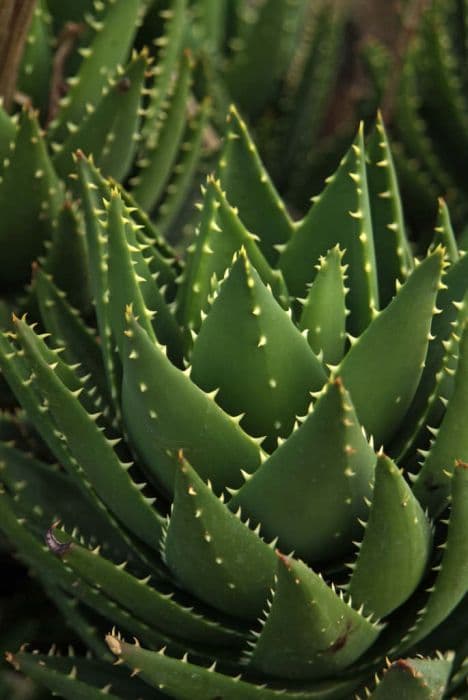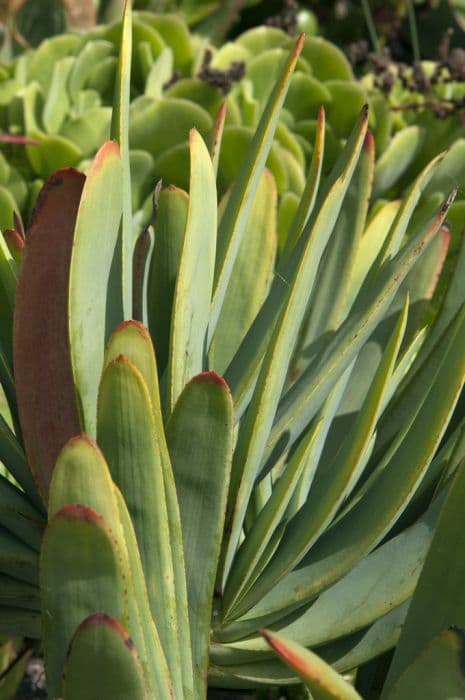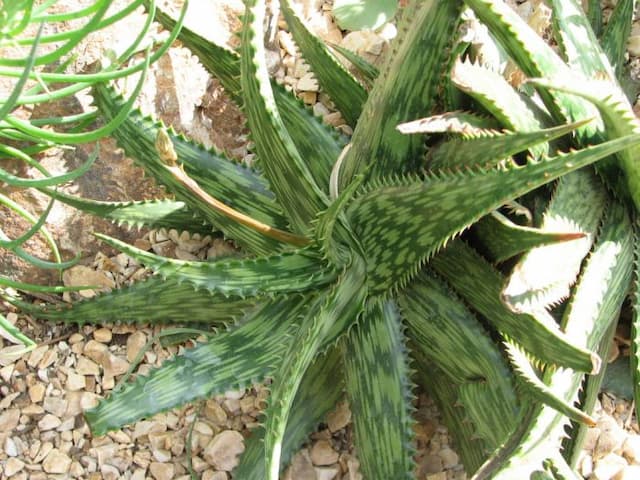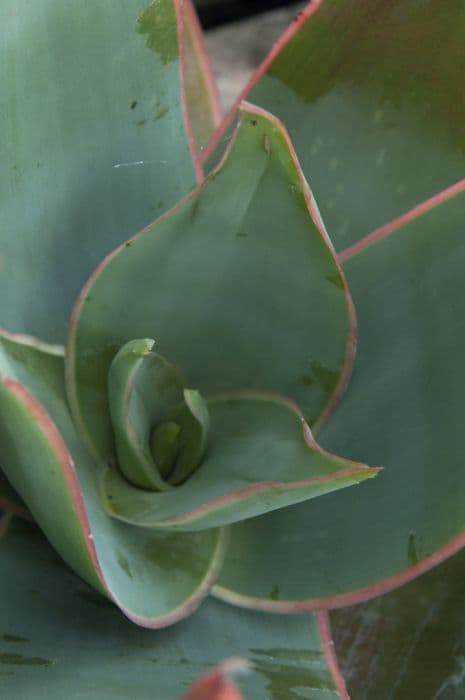Knoppies gasteria Gasteria baylissiana

ABOUT
Gasteria baylissiana, commonly known as "bayliss' gasteria," is a succulent plant that is recognized for its unique and attractive appearance. It features a rosette of fleshy, thick leaves that are tapered at both ends, resembling a tongue in shape. The leaves are a distinct pale gray-green color, often with a bumpy texture that gives them a rough and rugged look. Each leaf is adorned with distinctive white spots scattered across the surface, creating a speckled pattern that adds to its ornamental appeal. These spots may be spread out evenly or clustered, varying somewhat between individual plants. The surface of the leaves can also have tiny warts or tubercles, contributing to the tactile aspect of the plant. The leaves have a smooth, shiny surface with a slightly rough feel when touched due to the presence of small tubercles. One of the appealing aspects of bayliss' gasteria is the way its leaves curl inward, giving the rosette a sculptural and compact appearance. The edges of the leaves are not armed with teeth or spines, unlike many other succulent varieties, making bayliss' gasteria a friendly choice for spaces where people may brush up against it. Over time, the plant may produce offsets, leading to a cluster of rosettes which enhances its attractiveness as a potted houseplant or as part of a rock garden. In conclusion, bayliss' gasteria presents a delightful display of pale green foliage, enhanced by white speckles and a hardy texture that makes it both a visual and tactile experience.
About this plant
 Names
NamesFamily
Asphodelaceae
Synonyms
Knoppies Gasteria, Bayliss's Gasteria
Common names
Gasteria baylissiana.
 Toxicity
ToxicityTo humans
Gasteria baylissiana, commonly known as a type of Gasteria, is not known to be toxic to humans. There is no significant evidence to suggest that this succulent plant poses a health risk if ingested. However, it is generally not recommended to consume any part of ornamental plants. In the unlikely event that any symptoms do arise from ingesting Gasteria baylissiana, it is advised to seek medical attention.
To pets
Gasteria baylissiana, which is simply known as Gasteria in common parlance, is also not known to be toxic to pets such as dogs and cats. This means that if a pet were to ingest parts of the plant, it is unlikely to suffer from poisoning as a result. Nevertheless, ingestion of non-food items can sometimes cause gastrointestinal upset in pets, and if any concerning symptoms are observed, it would be prudent to consult a veterinarian.
 Characteristics
CharacteristicsLife cycle
Perennials
Foliage type
Evergreen
Color of leaves
Green
Flower color
Varies
Height
6-10 inches (15-25 cm)
Spread
6-10 inches (15-25 cm)
Plant type
Succulent
Hardiness zones
9
Native area
South Africa
Benefits
 General Benefits
General Benefits- Easy to care for – Gasteria baylissiana is a low-maintenance plant that requires minimal watering and can tolerate partial shade.
- Drought-tolerant – Being a succulent, it is well-adapted to survive in dry conditions, making it ideal for xeriscaping and water-wise gardens.
- Unique appearance – The plant's rosettes of fleshy, variegated leaves add an unusual and interesting aesthetic to plant collections or garden designs.
- Non-toxic – Safe around pets and children, as it is not known to be toxic if ingested.
- Compact size – It is a small plant which makes it suitable for growing in containers, indoors, offices, or small spaces.
- Propagation ease – It can be easily propagated through leaf cuttings or offsets, making it easy to multiply and share with others.
- Long-lived – Gasteria baylissiana is a perennial plant that can live for many years with proper care.
- Attracts wildlife – While it is not particularly known for attracting a plethora of fauna, it can still be a part of a habitat garden offering shelter to small insects.
- Adaptability – It is a versatile plant that can adapt to a variety of indoor conditions, making it well-suited as a houseplant.
 Medical Properties
Medical PropertiesThis plant is not used for medical purposes.
 Air-purifying Qualities
Air-purifying QualitiesThis plant is not specifically known for air purifying qualities.
 Other Uses
Other Uses- Gasteria baylissiana can be used as an ornamental addition to a terrarium, creating a miniature landscape that is easy to maintain due to its drought-resistant nature.
- Use Gasteria baylissiana in fairy gardens to add a unique, sculptural element that compliments the whimsical aesthetic of these miniature scenes.
- Combine multiple Gasteria baylissiana plants to form intriguing geometric patterns in rock gardens, showcasing their varied leaf forms and colors.
- Gasteria baylissiana's thick leaves can be used in mixed succulent arrangements to provide contrast through their distinctive texture and form.
- Cultivate Gasteria baylissiana in hanging baskets as their compact size and slow growth habit make them ideal for suspended displays.
- Incorporate Gasteria baylissiana into xeriscapes, landscapes that require minimal irrigation, due to their adaptability to arid conditions.
- The plant's ability to tolerate low light makes Gasteria baylissiana a suitable addition to office spaces where natural light may be scarce.
- Create a living centerpiece on dining tables with Gasteria baylissiana as a low-maintenance and long-lasting alternative to cut flowers.
- Propagate Gasteria baylissiana leaves to exchange with other plant enthusiasts or as a creative and sustainable gift option.
- Utilize Gasteria baylissiana's slow growth and small size by planting it in miniature bonsai pots for decoration on desks and shelves.
Interesting Facts
 Feng Shui
Feng ShuiThe Gasteria is not used in Feng Shui practice.
 Zodiac Sign Compitability
Zodiac Sign CompitabilityThe Gasteria is not used in astrology practice.
 Plant Symbolism
Plant Symbolism- Resilience: Gasteria baylissiana, commonly known as Knoppies Gasteria, is a succulent that can survive in tough conditions, symbolizing the ability to thrive despite adversity.
- Endurance: This plant's capacity to store water in its leaves represents endurance and the ability to withstand long periods of drought or difficulty.
- Protection: The thick skin and pointed leaves of the Knoppies Gasteria may symbolize protection and defense against harm.
- Serenity: Gasterias are often used in indoor and outdoor settings for their aesthetic and can represent tranquility and the creation of a peaceful environment.
 Water
WaterThe Gasteria, commonly known as "Knoppies Gasteria," should be watered sparingly, as it is drought tolerant and prone to overwatering. The soil should be allowed to dry out completely between waterings. Typically, watering once every two to three weeks is sufficient; however, this may vary based on climate and environmental conditions. Use lukewarm water and gently pour it directly onto the soil, using approximately 8 ounces per watering for a small pot, avoiding water on the leaves to prevent rot.
 Light
LightKnoppies Gasteria thrives best in bright, indirect sunlight. A spot near a north-facing window or a few feet away from a south-facing window is ideal to avoid the harsh direct afternoon sun which could scorch its leaves. The plant can also adapt to low-light conditions but may grow slower.
 Temperature
TemperatureKnoppies Gasteria prefers temperature conditions between 50°F and 85°F, making it well-suited for most indoor environments. It can survive minimum temperatures down to around 40°F but should not be exposed to frost. The ideal temperature for the plant is a comfortable room temperature, around 65°F to 75°F.
 Pruning
PruningPruning Knoppies Gasteria is generally done to remove any dead or damaged leaves and to maintain its compact shape. Pruning should be carried out as needed, using clean, sharp scissors or pruning shears. The best time for pruning is in the spring or early summer when the plant is actively growing.
 Cleaning
CleaningAs needed
 Soil
SoilGasteria requires well-draining soil mix, ideally a cactus or succulent mix with some added perlite or pumice for extra aeration. The ideal soil pH for Gasteria baylissiana, commonly known as Knoppies Gasteria, should be slightly acidic to neutral, in the range of 6.0 to 7.5.
 Repotting
RepottingKnoppies Gasteria should be repotted every two to three years or when it has outgrown its current pot. It's best to repot in the spring or summer during the plant's active growing period.
 Humidity & Misting
Humidity & MistingKnoppies Gasteria prefers low to moderate humidity levels, typical of indoor environments. It thrives best when the humidity level is around 40% to 60%.
 Suitable locations
Suitable locationsIndoor
Place in bright, indirect light and water sparingly.
Outdoor
Protect from frost, partial sun, well-draining soil.
Hardiness zone
9-11 USDA
 Life cycle
Life cycleGasteria baylissiana, commonly known as Bayliss's Gasteria, begins its life as a seed, which, when conditions are favorable, germinates in well-draining soil. The seedling stage follows, where it slowly develops fleshy leaves in a rosette pattern, characteristic of succulent plants. As it enters the juvenile stage, the plant continues to grow at a slow rate, with leaves getting more pronounced with the distinctive rough texture and pronounced margins. Upon reaching maturity, Gasteria baylissiana can produce inflorescences on tall spikes, bearing tubular flowers that are primarily pollinated by birds or insects. After pollination, seeds are produced and dispersed within the local area, ready to start the next generation if they find a suitable substrate. The adult plant has the ability to produce offsets, or "pups," which can be separated from the parent plant to propagate new individuals, thus continuing its lifecycle.
 Propogation
PropogationPropogation time
Spring-Early Summer
Gasteria baylissiana, commonly known as Knoppies Gasteria, can be propagated using leaf cuttings. To do this, a healthy leaf is selected and gently twisted from the plant, ensuring a clean break. It's crucial to let the leaf callous over for a few days to a week before planting to prevent rot. Once the cut end has hardened, the leaf can be placed in a well-draining soil mix, typically one with a combination of cactus potting mix and perlite or sand. The soil should be kept slightly moist but never waterlogged, with the container kept in a warm area with bright, indirect light. Roots usually develop within a few weeks, after which more regular Gasteria care can resume.









